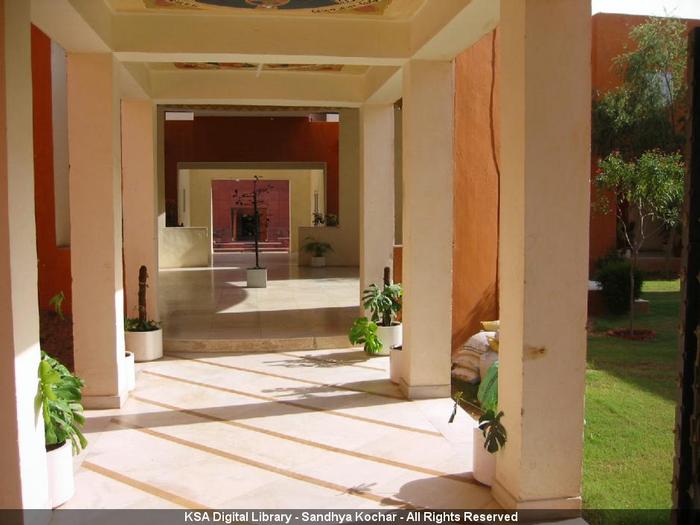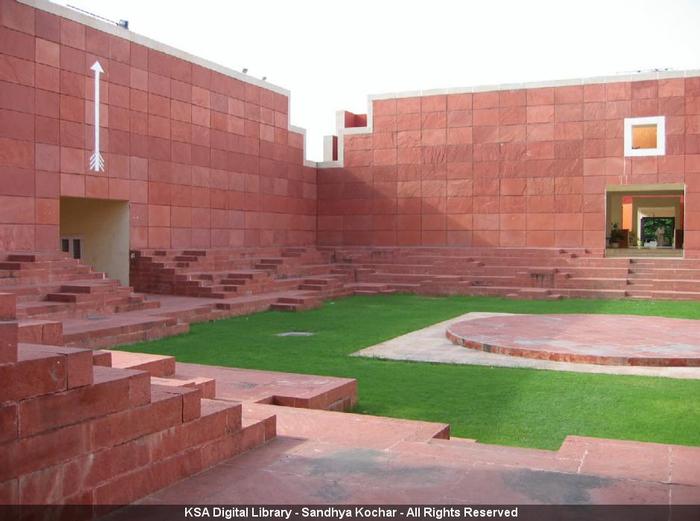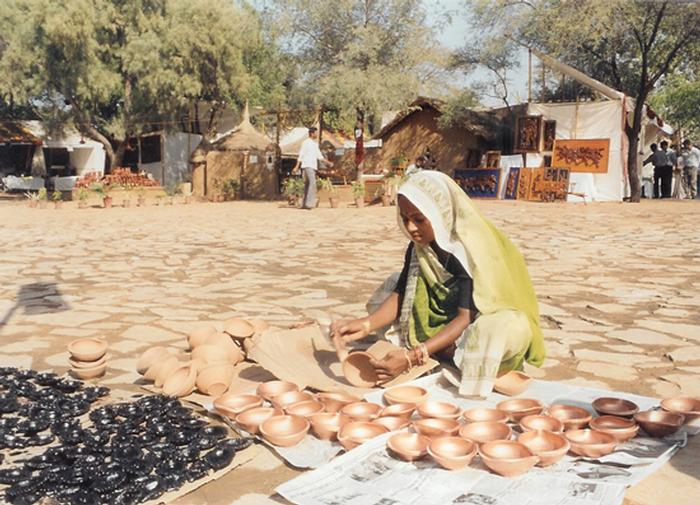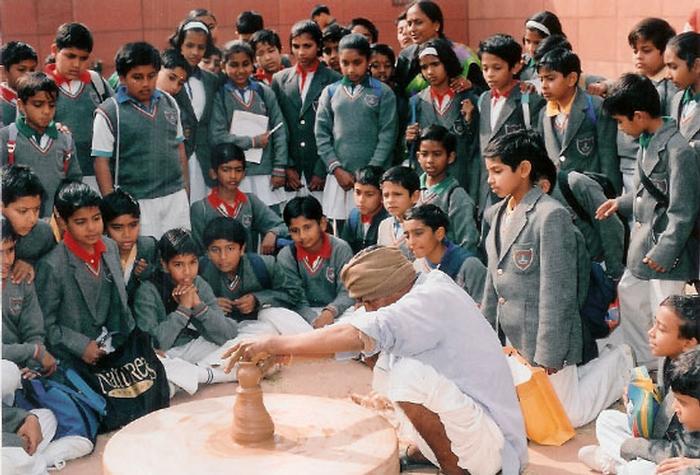Gauri Mathur EssayJawahar Kala Kendra- The artist's haven“All architecture is shelter, all great architecture is the design of space that contains cuddles, exalts, or stimulates the persons in that space.” - Philip Johnson Picture this: The sound of an occasional “Ektara” (one stringed musical instrument) or the husky voice of a folk singer; wonderful “Kalbelia” (traditional Rajasthani dance form) dancers embellished with silver trinkets dancing to the beats of a “Dholak” (percussion instrument); local folk showcasing and selling their craft; the excitement to purchase a terracotta "gullak" (Hindi: gullak- piggy bank) from the local fair; men and women jostling their way into the crowd to have a better view of the traditional puppet show; a medley of bright hues woven together in traditional fabric. These are memories of an innocent time when there was a whole new gamut of things to explore every moment. These are memories that I trace back to one location- The Jawahar Kala Kendra (Hindi: Kala - art / technique; Hindi: Kendra - centre / nucleus), a shelter of sorts which doesn’t house just people but a culture. Culture has various inter-related meanings. However in the context of a community it can be perceived as an integrated knowledge, beliefs, ideologies and customs which in many ways define the community under concern. It emanates from the unity of humankind in nature. Jaipur is also known as the ‘Pink city’ and is so called because of the pleasant terracotta coloured facades of buildings in most parts of the city. The city falls in the fabled Land of Kings – Rajasthan which is located in the north-western flange of India. The desert state of Rajasthan experiences extreme temperatures throughout the year. It has hot-dry summers and faces equally harsh winters. Despite the gruesome weather, the region has seen a rapid growth in terms of infrastructure, in the last few decades. The city of Jaipur has particularly seen an upsurge in population, with a large fraction of the influx hailing from rural sections. Owing to this growth the city is expanding its limits both geographically and culturally. In doing so there is a tendency to leave behind the local tradition and move towards a more globally accepted way of life. Many visible and significant cultural changes have taken place in the city in recent times. Across the nation, the lifestyle and leisure time activities of the people have changed. This shows a paradigm shift towards a modern lifestyle. This rapid transition in our lifestyle is resulting in a clash of ideologies and thought processes of sorts. In the midst all this chaos there are a few who care to look back and introspect. These few want to revive the tradition which is on the verge of becoming extinct. They want to renew the stature and the living conditions of those who could not cope with this fast paced life and still subsist on the traditional art which was passed on to them by their forefathers. They want to reconnect with their lost roots and move towards a more integrated growth. They want to adapt to the global culture without a loss of their core values and cultural identity. Among these few are the visionaries who brought about Jawahar Kala Kendra. Owned by the Rajasthan State government, Jawahar Kala Kendra popularly known as JKK is managed and funded by various NGOs across the country. Located in the heart of the city of Jaipur, Jawahar Kala Kendra is approached by the Jawahar Lal Nehru Marg (one of the major arteries of the city) and can be easily accessed by the local residents and tourists alike. Set in a huge 9.5 acre campus, the ‘Kendra’ is essentially an institution for the community, by the community. The Kendra was envisioned and conceptualised by Charles Correa in the year 1986. It is a reflection of his deep rooted concern to build spaces that match the Indian sensibilities; spaces that serve and connect with the culture and more importantly the people residing in a particular community. Correa laid special emphasis on prevailing resources, energy and climate as major determinants in the ordering of space. It is his art of blending the vernacular building techniques with a contemporary design and presenting something grand that truly sets the Kendra apart. The Kendra unlike other art galleries and centres for performing arts, does not showcase Art as an indulgence for the elite, but rather, as a tradition which everybody can experience and be a part of. In this centre for arts, economic and social status is not a barrier. It thrives on the concept of ‘accessible art’. This in fact is the quintessence which brings people from all over the city and beyond to culminate and appreciate all forms of art under one roof. The energy that the Kendra exuberates draws people to it. It is thronged by visitors, art lovers, artists, tourists and others throughout the year. Built with the vision of preserving local heritage, the Kendra offers a shelter to the local Rajasthani art forms and paves way for artists of the future. This facility includes a permanent ethnographical art gallery called The Alankar Museum (Hindi: alankar – “ornament”) which depicts the tangible and intangible heritage of Rajasthan, through a vast range of artefacts exhibited here. Another six exhibition galleries presently function as exhibition spaces. Local as well as international artists have displayed various forms of fine art, often addressing social and global issues in these galleries. They have experimented with various traditional art forms, giving them a modern perspective so as to preserve and nurture the culture while catering to a global audience. These exhibition spaces alternatively serve as workshop areas as well. During different parts of the year they offer an interactive playground for artists, students and connoisseurs to learn and share. Various organizations across the state like Jaipur Rotract Club and NGOs like Muskaan (Hindi: muskaan-“smile”) and Pankhuri (Hindi: pankhuri – “flower petal”) dedicated to teaching physically handicapped and visually impaired children, and various other organizations conduct events for school-going children. This is an attempt to sensitize young minds about the on-going socio-economic and environmental crisis across the world. The well endowed documentation section (library and audio-visual division) contains a vast range of publications on theatre, fine arts and music, thus, attracting scholars and art connoisseurs from far. Apart from the art galleries there are theatres and conference halls which have seen various scholars and performers of all age groups in a vast array of cultural programs. Adjoining the main building of the Kendra is Shilpgram- a rural complex symbolizing the rural ambience of various regions of Rajasthan. This rural setting is a reflection of the way of life of the indigenous folk of Rajasthan. Small huts built in mud, with thatched roofs play host to artisans from various regions in and around Rajasthan. They display and sell their craft in these replicas of their indigenous rural houses. This setting not only makes the rural folk feel close to the desert landscape but also gives the onlookers an insight into their way of life. The exuberance and vibrancy of the local artists despite the adversity that they have to face is awe inspiring. The Shilpgram also hosts colourful dance and musical performances throughout the year which attracts a huge number of visitors from across the country. The plan of Jawahar Kala Kendra is a reflection of the original city plan of Jaipur which is based on the concept of nine Mandalas or Navagraha (nine planets) placed in a grid pattern with one block displaced diagonally to accommodate the main entrance. The ingenuity of the plan however is in the representation of these nine blocks as the nine planets with each block characteristic of its respective planet. For instance the library is located in the Jupiter section which represents knowledge and wisdom. The cafeteria is located in the lunar section which represents various myths about astronomy; directly translating into the unexplored gastronomic ventures of the visitor. The Venus section, representing art and beauty houses the theatre. Rahu (Ascending node) represents the Devourer and Restorer. This section hence houses the documentation section symbolising the restoration. The Mars section representative of power has the administrative block. Built in red sandstone with white marble coping, the building blends very well with the traditional architecture. Traditional concepts of courtyard planning and mutual shading for natural cooling have been incorporated in the basic design of the spaces. Also each block represents its respective planet in the form of a motif or cut- out on the exterior facade or flooring pattern, as symbolised in Indian mythology. For instance- bow for Mercury, crescent for Moon, sword for Rahu etc. Another architectural element which has been beautifully executed is the interplay of light and shadow in the building. Different blocks with varying heights, cast shadows on each other. Pergolas and fenestrations in the walls create dramatic effects of sunlight; as one moves from one block to the other the spectator experiences a different state of illumination. The use of skylights is meticulously done to engulf just the right amount of sunlight into the built space. The visitors are welcomed into the building through the main entrance hall. Topped with a huge circular dome which is decorated with traditional murals on the inside, the entrance provides a glimpse of what lies ahead. As one passes through the beautiful sun lit corridors he experiences a transition into a new dimension. It isn’t just the four walls that contain “You”, the paintings on the walls, floors and roofs guide you through the pages of history. Memories give shape to a building and experiences enrich it. The paintings take you back into the time when forces of nature guided the course of life. These corridors are flanked by small landscaped courtyards on either side. Adorned with sculptures designed by contemporary artists these sculptures offer a stark contrast to the ancient paintings. Interesting circulation patterns are created within the space by the use of several openings in each of the nine blocks. The astrological element is not only restricted to the planning of the building but is liberally represented throughout the building in the form of paintings and murals depicting ancient Indian symbolism of planets and position of stars.The cafeteria is a very interesting space where the lunar cycle is depicted in the fixed marble and granite furniture. People from different fraternities often sit and relax in this space and one surely ends up striking an interesting conversation with a local artist or fellow student. The central amphitheatre is also a striking feature in the design. It has a square plan with a circular stage in the centre offering a three sixty degree view of the audience to the performer. This offers the artist maximum scope for interaction. Steps of varying heights built in the same red sandstone act as seating. The entire space has a very casual and relaxed feel to it. The Kendra emanates a sense of freedom. It propagates creativity and helps the artists to think out of the box: to create something wonderful and new, yet inspired by its roots. The Kendra offers a wonderful platform for pondering over various social issues. It promotes the showcasing of drama and other art forms all over the world which address issues like child labour, dowry system, women empowerment etc to a great extent. The Kendra is a forum for discussing these issues and creating awareness amongst people. Most of the traditional art forms such as paintings and folklore teach us to respect Mother Nature. It is for us to learn and imbibe these values into our day to day scheme. The Kendra with its promotion for traditional art also offers a drive towards a more environmentally conscious society. Theatre reflects the society and attempt to reform the society. The core work of the theatre section of the Kendra is not only to display the dramas; but also, to relate these with the new and veteran genres. Activities carried out here are designed to provide the ideal platform to bridge the gap between the artist, students, scholars, with the integration of different modern theatre forms and a movement towards a multi disciplinary approach towards the understanding, dissemination and propagation of theatre. Music inspires man more than anyone or anything else because it appeals to the core of his self, arouses his feelings and so stirs his being that he cannot help dancing. Music and dance give cheer and comfort and richness to life. They bring beauty to our materialistic world and add flavour to our monotonous routine. Rajasthan is amazingly rich in both classical and folk music and dance. These act as a medium to entertain and teach people about the simple ways of rural living. Showcasing the Rajasthani folk music and dance not only serves as an opportunity to make people conscious of their culture but also helps boost the morale and status of these ambassadors of various dying art forms. The Kendra with its various new initiatives is reaching out to several regional and tribal artisans. As a part of their outreach programs the organization documents various local performing and fine arts in their ingenious settings. They then present it to a wider audience so that they may appreciate and lend their support to the perishing art forms. It is an attempt to acquaint the urban population with the lesser known genres of Rajasthani art forms and bridge the gap between the urban and rural culture. The Kendra offers a platform to the economically deprived artists to showcase their talent. The Kendra holds great public significance as it is an attempt to make people aware of a lost culture. It is an attempt to break-away from the mindless venture towards money driven way of life. It is to appreciate the honour and pride of the place where we come from. It is to share and experience a culture which anchors us to our roots. Our history enriches us and paves way for a better future. It helps in the growth of a civilization as a whole, and of the intelligence and intellect of individuals as well. The traditional art teaches us to live in harmony with one another and our ambient surroundings. An artist’s haven, an architect’s refuge, Jawahar Kala Kendra is an extraordinary building that will continue to inspire one and all. It fosters a communion of people from different backgrounds. It serves and promotes the less privileged. It strives for a harmonious community rich in traditional values and culture. It is an experience to be cherished and shared with people who are inconspicuously entwined in our daily lives. It is to acknowledge the core of our existence. It is to honour those who still respect their indigenous traditions. It is a space that exalts and stimulates anybody who enters it. Additional Help and InformationAre you in need of assistance? Please email info@berkeleyprize.org. |
|




